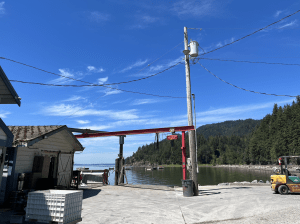Hello! My name is Livvy Eickerman. I am a rising senior majoring in Biology and Environmental Studies. This summer I have had the opportunity to work with NOAA at their Northwest Fisheries Science Center located in Seattle, Washington.
This summer I have worked on three different projects. One is research-oriented, compiling a database of all large dams on the west coast affecting Salmonidae’s ability to migrate upstream. Another is analyzing the diet of Salmonidae from a logging project on the Olympic Peninsula. The third, which I will explain more in detail, has been helping a grad student from UW with his field days.
On field days, I meet up with Karl, the grad student, and we drive the white pick-up truck up north to one of the three locations he has chosen. On my favorite field day this summer, we went up to Samish. We met up early in the morning, yawns abundant. Once we got to Samish, we drove down an old road to pull over near a railroad track, then tugged on our waders and tied up our boots. We took the bucket out of the back and hauled the net out.
The main way of collecting specimens in his research is through seining. Gill netting used to be the main way aquatic research was done. However, gill nets kill fish as they are collected. Seine nets have a different way of tying the net together which lets the fish stay alive. These nets are extremely bulky and extremely heavy. At least double if not triple the length of a volleyball net, with an added sail cloth at the bottom, when dry, the net is bulky at best, but when wet, it is like carrying bricks.
Karl and I lugged the net down to the water, and he explained what we were seeing. It was a beautiful day on Puget Sound. The water was sparkling, the San Juans were rocky and resolute, and there was a light, warm breeze. After grabbing some last sips of water and bites of food, we grabbed the net and started seining.
Seining is one of the hardest things I have done physically for a job. You are dragging the weight of the net as well as your full body weight through the water, mud sucking at your boots and the current often attempting to hold you back. To keep up with Karl, I was leaning forward with all my body weight.
Once you have walked through the water for enough time, the two ends of the seine (Karl and I) come together and see what we’ve collected. The process of bringing the net in involves reaching down into the water and quickly pulling both the top of the net and the bottom of the net towards your body. After a full day of seining, you realize there is nothing better than the sound of fish tails flapping around when you pull the conical tail of the net in. You then select the species that are part of the study and release the rest.
On field days I saw shrimp, shore crabs, English sole, eel fish, various amorphous blobs, sea lettuce, and more. “Bye-bye, little guy!” Apparently isn’t heard often on field days, as I was given a lot of grief by Karl for my exclamations of how cute the creatures were.
Once enough specimens have been collected or the tide has turned, it’s time to call it a day. Karl has a big sweet tooth, so after hauling our samples and the net back to the pick-up truck, extremely satisfied, there is always a twix or milky way bar in the car, all that’s left to do as we drive in exhausted, satisfied silence back to Seattle.
Experiences like Livvy Eickerman’s are made possible by the Whitman Internship Grant, which provides funding for students to participate in unpaid internships at nonprofit, some for-profit, and government organizations. We are happy to be sharing blog posts from students who were supported by either a summer, fall, spring, or year-long grants at organizations, businesses, and research labs all around the world. To learn how you could secure a Whitman Internship Grant or host a Whitman intern at your organization, contact us at ccec_info@whitman.edu.


